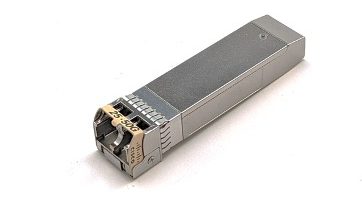
Craig Pasek, Product Manager
Cisco Optics
New 50G transceiver product family
As network operators look to upgrade their medium-speed Ethernet links, they can take advantage of a Cisco’s new optical transceiver product family “SFP-50G”. These modules are 50G transceivers in a form factor called SFP56 (see Figure 1). They deliver double the data rate of SFP-25G (SFP28 form factor) and in the same basic SFP form factor.
Unlike QSFP-40G and QSFP-100G transceivers, which both use four electrical lanes at lower speeds (4 x 10G and 4 x 25G, respectively), SFP-50G features a single electrical lane. As a result, it can interface directly with the latest generation switch ASICs that incorporate 50G serializers/deserializers (SerDes), eliminating the need for additional gearboxes with PAM4 encoders/decoders. Thus, SFP-50G provides a boost in performance of 50G with a design that minimizes cost, space and power consumption.

From a historical perspective, let’s look at the evolution of the QSFP-100G and SFP-25G markets, both based upon the 25G SerDes. The first devices to reach the market were the QSFP-100G optical modules, based on four electrical lanes of 25G SerDes in the QSFP28 form factor. This allowed transceiver module suppliers to offer 100G capability. SFP-25G modules were not widely available until years later. A similar dynamic is in play now for SFP-50G. Because of the broad focus on QSFP56-DD 400G modules, the market for 50G SerDes and ASICs is now mature, resulting in high reliability and low cost. This situation enables the development and commercial growth of SFP-50G modules.
The SFP56 value proposition
Compared to the workhorse SFP-25G, the SFP-50G delivers double the data rate in the same form factor. Historically, that trend has led to dramatic decreases in cost per bit. Switch vendors are already developing switches with SFP ports that can support 1G, 10G, 25G, and 50G rates. These products give network operators the freedom to operate each link at the data rate that best fits demand at any given time just by selecting the appropriate transceiver type: copper, SMF or MMF and the desired speed in SFP, SFP-10G, SFP-25G and now SFP-50G.
To support this trend, Cisco’s SFP-50G product family contains a comprehensive portfolio of transceivers ranging from copper-based solutions of a few meters to optical modules with reaches of up to 15 km and even greater in the future. These transceivers support 50G and 25G dual rate, which allows them to connect at the new the 50G rate while also connecting with 25G transceivers. This gives network operators a cost-effective migration path from 25G to 50G by enabling partial network upgrades.

Network operators need flexible, reliable upgrade paths to serve a variety of client needs. SFP-50G gives them the option of a significant capacity increase in a familiar form factor that helps reduce cost per bit. Cisco’s SFP-50G transceiver product line, a broad 50G portfolio, lets network operators choose the optimal solution for a variety of network segments.
Read the white paper to learn how SFP-50G solutions can enhance your network:
The Key Role of 50G in Today’s NG Networks
Resources
Compatibility matrix for SFP-50G

This is awesome and it’s the need fo an hour, indeed !